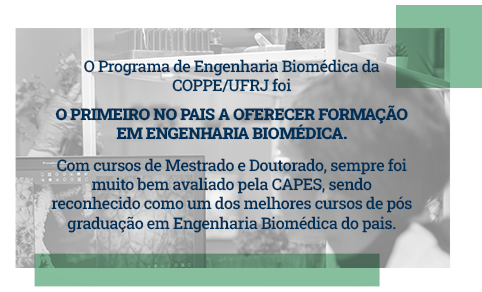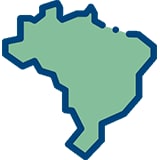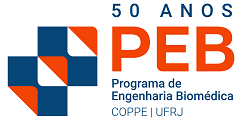The first training in Biomedical Engineering in the country was offered by the Biomedical Engineering Program of COPPE / UFRJ (see magazine published to celebrate PEB’s forty years). With Master’s degree and Doctorate courses, it has always been very well evaluated by CAPES as one of the best graduation courses in Biomedical Engineering in the country. The program has 6 (six) laboratories whose names are similar to the research areas to which they belong (see brochure), and that offer a solid training for research as well as preparation for the job market. Although it does not have its own undergraduate courses, it continuously acts in different undergraduate courses in engineering, exact sciences and health. It is the unique graduation course in Biomedical Engineering that accepts students from both areas. This allows the exchange of experiences between the two worlds that Biomedical Engineering intends to unite.
 The Biomedical Engineering Program
The Biomedical Engineering Program
 The first training in Biomedical Engineering in the country was offered by the Biomedical Engineering Program of COPPE / UFRJ (see magazine published to celebrate PEB’s forty years). With Master’s degree and Doctorate courses, it has always been very well evaluated by CAPES as one of the best graduation courses in Biomedical Engineering in the country. The program has 6 (six) laboratories whose names are similar to the research areas to which they belong (see brochure), and that offer a solid training for research as well as preparation for the job market. Although it does not have its own undergraduate courses, it continuously acts in different undergraduate courses in engineering, exact sciences and health. It is the unique graduation course in Biomedical Engineering that accepts students from both areas. This allows the exchange of experiences between the two worlds that Biomedical Engineering intends to unite.
The first training in Biomedical Engineering in the country was offered by the Biomedical Engineering Program of COPPE / UFRJ (see magazine published to celebrate PEB’s forty years). With Master’s degree and Doctorate courses, it has always been very well evaluated by CAPES as one of the best graduation courses in Biomedical Engineering in the country. The program has 6 (six) laboratories whose names are similar to the research areas to which they belong (see brochure), and that offer a solid training for research as well as preparation for the job market. Although it does not have its own undergraduate courses, it continuously acts in different undergraduate courses in engineering, exact sciences and health. It is the unique graduation course in Biomedical Engineering that accepts students from both areas. This allows the exchange of experiences between the two worlds that Biomedical Engineering intends to unite.
O PEB conta com um quadro de 14 docentes plenos, 3 professores colaboradores, 3 pós-docs e 4 funcionários técnicos e administrativos.
Acesse AQUI o Livreto de 40 anos do Programa de Engenharia Biomédica.
 A Short History
A Short History
In 1970, the Biomedical Engineering Program was born in a laboratory that applied electronic instrumentation to medicine at COPPE / UFRJ. Although the area was unknown at that time, it attracted bachelors in engineering and exact sciences as well as in biological and health sciences.
In these forty years of experience, PEC awarded more than 364 master’s degrees and 85 doctorate degrees in sciences. In 2011 the faculty of PEB was composed by 16 professors and its technical and administrative staff by 7 members.
 The Course Quality
The Course Quality
Score 7 The master’s degree program is accredited by the Federal Education Council since 1981, always obtaining concept “A” in CAPES / Ministry Education evaluations conducted up to 1997. The doctorate course was accredited by the Ministry of Education in 1995 and also obtained concept “A” in CAPES evaluations ( 1996 and 1997). With the new CAPES evaluation system (1998)of master’s degree and doctorate courses, PEB / COPPE obtained initially concept 6 (in a scale of 1 to 7), and from 2007 onwards, it became the unique course in Biomedical Engineering in the country to obtain concept 7.
 Undergraduate
Undergraduate
PEB’s professors have regularly lectured at UFRJ Electric and Electronic Engineering and Computer Science courses, collaborating with those departments. From 2001, PEB started teaching some disciplines in the undergraduate course in Medical Physics, also coordinating the course and offering new topics. PEB also has activities in the undergraduate course of the Mechanical Engineering Department of EE/ UFRJ, with emphasis in Acoustic Engineering and Control and Automation, where it offers a course of the Biomedical Engineering program (COB 502) that can be attended by students of all Engineering courses of POLI / UFRJ.

Atuação e Cooperações Nacionais
No país, o PEB tem atuado em atividades de assessoria e cooperação científica com diversos departamentos de diferentes instituições. Salienta-se ainda a atuação de docentes do Programa na direção da Sociedade Brasileira de Engenharia Biomédica.

Inserção Internacional
A inserção internacional do PEB/COPPE é evidenciada pelo número expressivo de acordos de cooperação científica com movimentação bilateral de professores e alunos. Nos últimos quatro anos houve interação com 20 instituições internacionais e participação em três redes multicêntricas envolvendo países da Europa e da América-Latina.
 National cooperation and activities
National cooperation and activities
In the country, PEB has been involved in advisory activities (Ministry of Health, National Agency of Health Surveillance – ANVISA and INMETRO) and scientific cooperation with several departments of UFRJ, FIOCRUZ, School of Pharmacy and Institute of Physics of UFF, Hypertension Division of the National Institute of Cardiology, INCA-MS National Cancer Institute, São Vicente de Paulo Hospital, Medical Informatics Discipline of the School of Medical Sciences of UERJ and Department of Biomedical Engineering of UFSJ. It is also worth mentioning the performance of the program's professors in the direction of the Brazilian Society of Biomedical Engineering and as associate editors of the Brazilian Journal of Biomedical Engineering.
 International Insertion
International Insertion
The program has developed a strong international insertion, through scientific cooperation agreements with the Medical Physics Department of Leicester University, United Kingdom and the neonatal Intensive Care Unit of the King’s College Hospital of London University; the Department of Anesthesiology, University of Dresden, Germany and the Massachusetts General Hospital, USA, ALFA-CEE Project, Consortium Research Project (CYTED - SUCODIC), participation of visiting professors and internships for teachers and students. In addition, since 1992, PEB faculty members have participated in committees of international scientific associations, such as the Board of Directors and the Health Technology Assessment Division of the International Federation of Medical and Biological Engineering (IFMBE); the Board of Directors of the International Union for Physical and Engineering Sciences in Medicine (IUPESM) and the direction of the Regional Council for Latin America of Biomedical Engineering (CORAL). Another relevant aspect is the participation of a PEB professor as associate editor of IEEE - Transaction on Medical and Biological Engineering and Medical Engineering and Physics.










